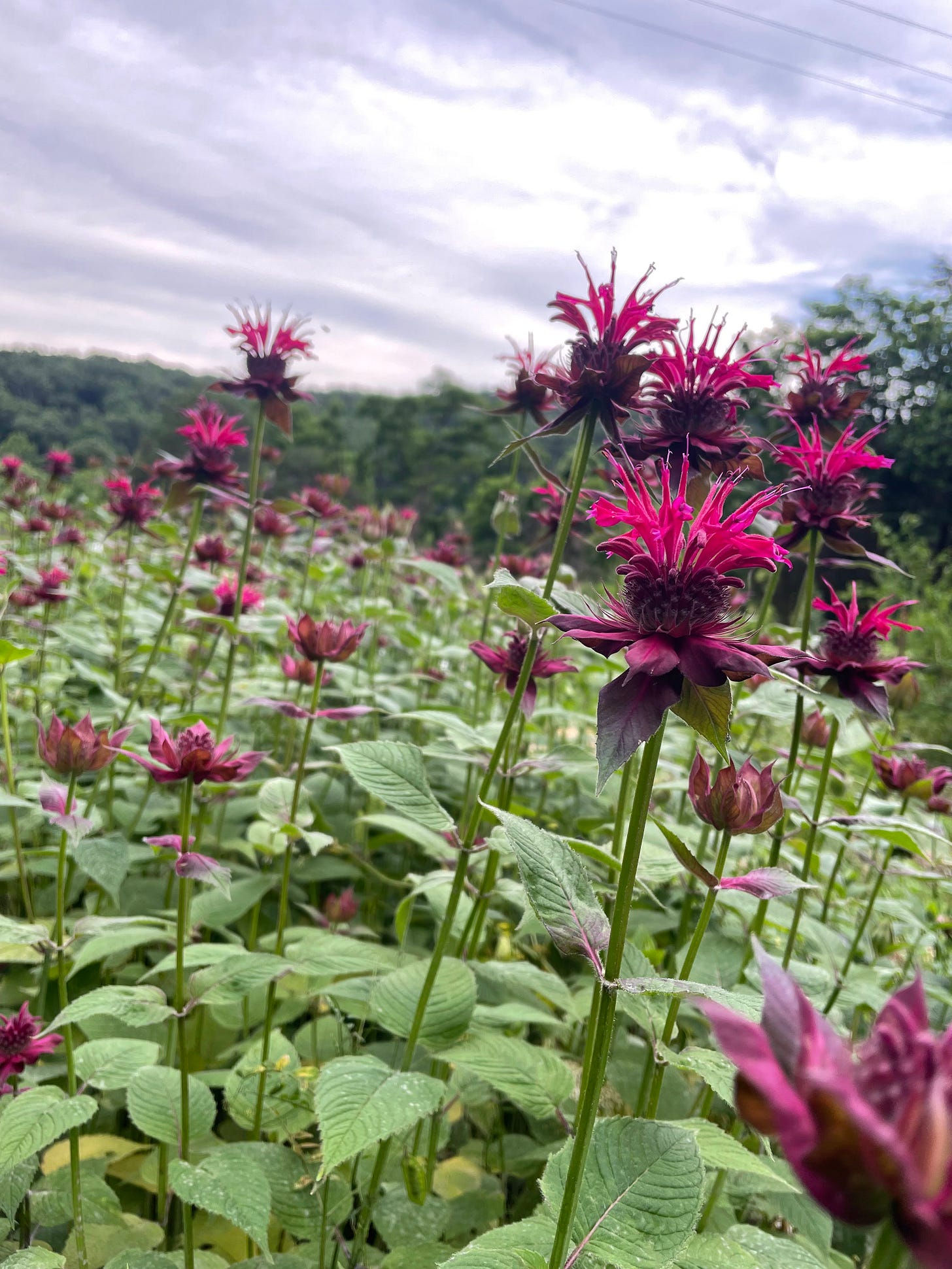Have you had your mint-family plant today?
Maybe the tastiest thing you can do for long term health
Summary: Plants in the mint family tend to be rich with medicinal components, and are especially great at supporting our immune and nervous systems. They can do everything from cure a cold to kill cancer cells and improve memory. Many cultures place a strong emphasis on mint family plants, from Za’atar (Origanum syriacum) in Palestine to the Italian classic basil. (Perhaps a reason the Mediterranean diet is so healthy?)
One of the most fascinating chemicals in these mint family plants is rosmarinic acid. It has been widely studied for a variety of ailments, and is especially interesting for its beneficial impact on the immune and the nervous systems. There are lots of other beneficial chemicals in these plants as well, especially the aromatic ones, and they often work in synergy with the rosmarinic acid to provide powerful medicine! While herbalists generally don’t reduce plants to isolated chemicals (that’s a pharmacist’s job) it can be interesting and helpful to see how families of plants are linked by common chemicals.
Here’s a list of mint-family plants that grow well here that are rich in rosmarinic acid, starting with the plants that have it in the highest concentrations (source: Duke’s Phytochemical database1). Make it a point to eat and drink them!
Self-heal/heal-all - Prunella vulgaris**
Oregano - Origanum vulgare
Garden Sage - Salvia officinalis
Lemon balm - Melissa officinalis
Spearmint - Metha spicata**
Rosemary - Rosmarinus officinalis
Clary sage - Salvia scalarea
Apple mint Mentha x rotundifolia**
Peppermint Mentha x piperita
Thyme Thymus vulgaris
Summer Savory Satureja hortensis
Ground ivy - Glechoma hederacea**
Bee balm -Monarda fistulosa*
Basil - Ocimum basilicum
Bee balm - Monarda didyma*
Lavender - Lavandula angustifolia
Hyssop - Hyssopus officinalis
Perilla/Shiso - Perilla frutescens**
Catnip - Nepeta cataria
*native
**Can naturalize in KY and be found growing in the wild (so be careful where you plant it!), weedy, may be invasive
Deeper Dive
Rosmarinic acid is a badass chemical. Here’s some of what we know about it, based on scientific research:
Strong antioxidant activity
Inhibits the death of neuronal cells/neuroprotective
Antidepressant
Protects against Alzheimer’s amyloid-β peptide induced neurotoxicity in cell cultures
Limits the production of pro-inflammatory chemicals
Anti-inflammatory
Reduces pain
Interacts with T cells to improve immune response to cancer, infection, allergy and autoimmunity, in a way that may be safer than immunosuppressive drugs
May positively affect sleep by modulating GABA and acetylcholine
Antimicrobial
Protects against mitochondrial dysfunction
Anti-wrinkle effect/promotes collagen production in skin
Let’s dig a little deeper into some of the common mint family plants that are rich in beneficial chemicals:
In a study on common sage (Salvia officinalis) in people with Alzheimer’s disease, the research subjects were given 60 drops / day of a sage extract or a placebo. After 4 months, the people taking sage had significantly better outcomes on cognitive functions than the placebo group (Akhondzadeh et al., 2003). In other words, there’s a reason the plant is called “sage.”
Similarly, lemon balm (Melissa officinalis) has both a long history of use for memory and nervous system support as well as modern research to support its efficacy in these areas. Maude Grieve (1931) reports:
John Hussey, of Sydenham, who lived to the age of 116, breakfasted for fifty years on [lemon] Balm tea sweetened with honey, and herb teas were the usual breakfasts of Llewelyn Prince of Glamorgan, who died in his 108th year. Carmelite water, of which [lemon] Balm was the chief ingredient, was drunk daily by the Emperor Charles V.
Grieve also references an excerpt from The London Dispensary (1696): “An essence of [lemon] Balm, given in Canary wine, every morning will renew youth, strengthen the brain, relieve languishing nature and prevent baldness.”
We’ve known for hundreds of years that lemon balm is good for the brain and nervous system, but what does the research say?
A randomized controlled trial of Iranian high school girls with PMS found a significant decrease in symptoms in the girls taking lemon balm, with further decrease in symptoms after three months (Akbarzadeh et al., 2015). Likewise, Scholey et al. (2014) conducted a study on the mood and cognitive effects of food that contained lemon balm and found that the herb significantly improved the subjects' mood, including lowering anxiety levels.
Several studies have been conducted on lemon balm that show positive improvements in cognitive function in people with Alzheimer’s (Noguchi-Shinohara et al., 2020). While the sample sizes in these studies have been relatively small, when this research is coupled with a long history of use for lemon balm (and similar mint family plants high in rosmarinic acid) for memory improvement, we can conclude that lemon balm is an incredibly useful herb for brain health.
There’s plenty more to say, and lots more research to support using these mint-family plants as daily health tonics. We have just scratched the surface, but hopefully it’s enough to encourage you to make a place for these herbs in your life!
How to use?
All the herbs in the list above can be tinctured or used in tea. Many of them also make excellent glycerin extracts. Many plants that you might typically use as a spice also make a great tea. Experiment - try a cup of rosemary tea and see what you think!
References:
Akbarzadeh, M., Dehghani, M., Moshfeghy, Z., Emamghoreishi, M., Tavakoli, P., & Zare, N. (2015). Effect of Melissa officinalis Capsule on the Intensity of Premenstrual Syndrome Symptoms in High School Girl Students. Nursing and Midwifery Studies, 4(2), e27001. https://doi.org/10.17795/nmsjournal27001
Akhondzadeh, S., Noroozian, M., Mohammadi, M., Ohadinia, S., Jamshidi, A. H., & Khani, M. (2003). Salvia officinalis extract in the treatment of patients with mild to moderate Alzheimer's disease: a double blind, randomized and placebo-controlled trial. Journal of clinical pharmacy and therapeutics, 28(1), 53–59. https://doi.org/10.1046/j.1365-2710.2003.00463.x
Connelly, A. E., Tucker, A. J., Tulk, H., Catapang, M., Chapman, L., Sheikh, N., Yurchenko, S., Fletcher, R., Kott, L. S., Duncan, A. M., & Wright, A. J. (2014). High-rosmarinic acid spearmint tea in the management of knee osteoarthritis symptoms. Journal of medicinal food, 17(12), 1361–1367. https://doi.org/10.1089/jmf.2013.0189
Girgenti, A., Picone, P., Buttacavoli, M., Palumbo, L., Naselli, F., Presti, E. L., Pecora, D., Cipollina, C., Annunziata, F., Pinto, A., Tamborini, L., & Nuzzo, D. (2025). Mitochondria-targeted rosmarinic acid: Its role against oxidative damage. Biomedicine & pharmacotherapy = Biomedecine & pharmacotherapie, 187, 118114. https://doi.org/10.1016/j.biopha.2025.118114
Grieve, M. (1931). Lemon Balm. A Modern Herbal. Retrieved from https://www.botanical.com/botanical/mgmh/b/balm--02.html
Iwahashi, H., Kawashima, Y., Masaki, H., & Taga, A. (2025). Lemon Balm (Melissa officinalis L.) Leaf Extract Promotes Endo180 Production in Dermal Fibroblasts and has Antiwrinkle Effect on Human Skin. Photodermatology, photoimmunology & photomedicine, 41(2), e70006. https://doi.org/10.1111/phpp.70006
Lee et al. Rosemary (rosmarinic acid) In Aggarwal BB, Kunnumakkara AB. (2009). Molecular targets and therapeutic uses of spices. World Scientific, Singapore.
Luo, C., Zou, L., Sun, H., Peng, J., Gao, C., Bao, L., Ji, R., Jin, Y., & Sun, S. (2020). A Review of the Anti-Inflammatory Effects of Rosmarinic Acid on Inflammatory Diseases. Frontiers in pharmacology, 11, 153. https://doi.org/10.3389/fphar.2020.00153
Medicine From the Earth 2020 Conference, Lecture notes.
Noguchi-Shinohara, M., Ono, K., Hamaguchi, T., Nagai, T., Kobayashi, S., Komatsu, J., Samuraki-Yokohama, M., Iwasa, K., Yokoyama, K., Nakamura, H., & Yamada, M. (2020). Safety and efficacy of Melissa officinalis extract containing rosmarinic acid in the prevention of Alzheimer's disease progression. Scientific reports, 10(1), 18627. https://doi.org/10.1038/s41598-020-73729-2
Scholey, A., Gibbs, A., Neale, C., Perry, N., Ossoukhova, A., Bilog, V., … Buchwald-Werner, S. (2014). Anti-Stress Effects of Lemon Balm-Containing Foods. Nutrients, 6(11), 4805–4821. https://doi.org/10.3390/nu6114805
Tubbs, A. S., Kennedy, K. E. R., Alfonso-Miller, P., Wills, C. C. A., & Grandner, M. A. (2021). A Randomized, Double-Blind, Placebo-Controlled Trial of a Polyphenol Botanical Blend on Sleep and Daytime Functioning. International journal of environmental research and public health, 18(6), 3044. https://doi.org/10.3390/ijerph18063044
There are over 29,000 plant chemicals represented in Dr. Duke’s Phytochemical database. If you like to nerd out on on plants, you need to know about Jim Duke and this resource:
https://phytochem.nal.usda.gov/?type=chemical&keyword=





